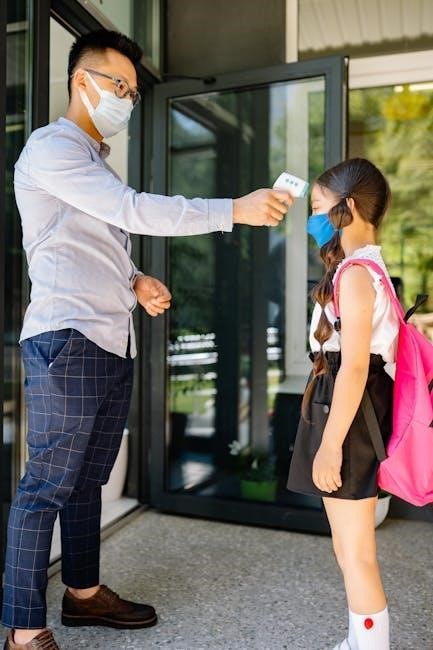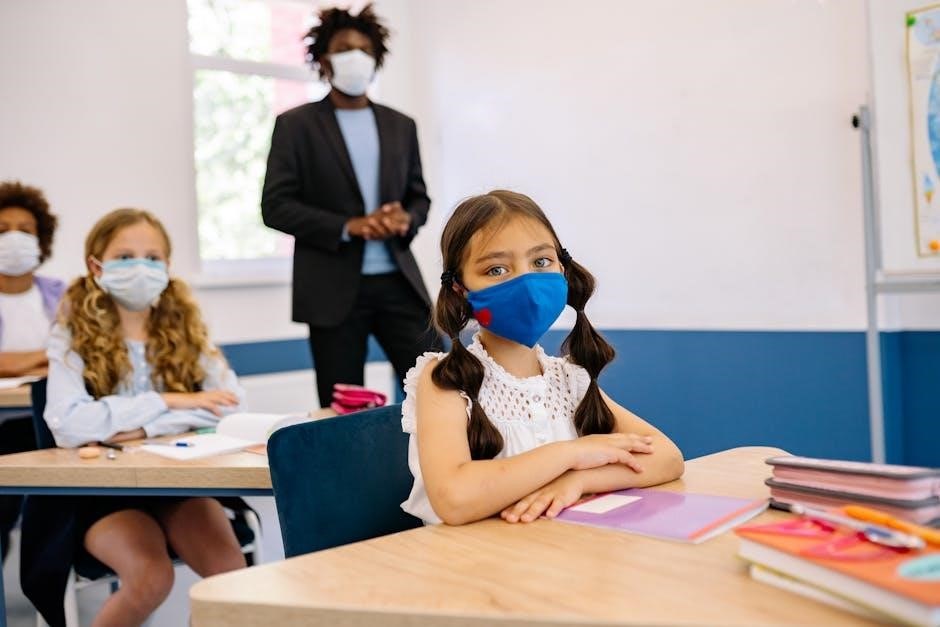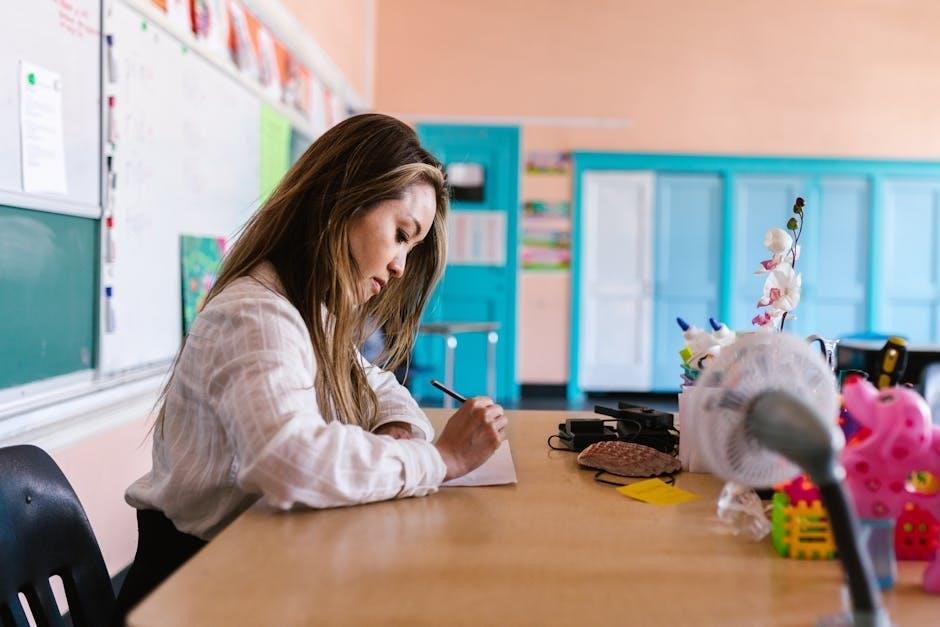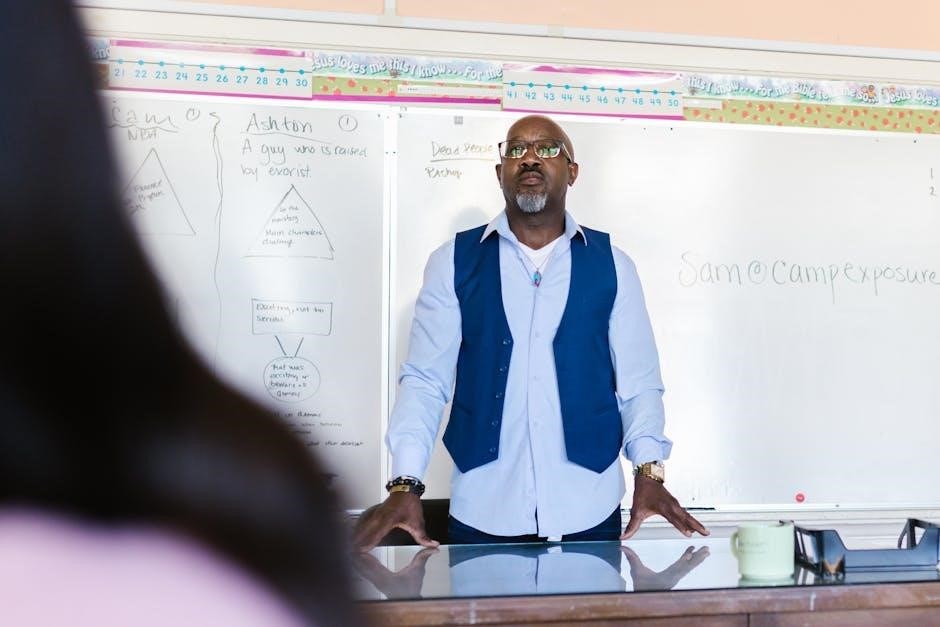Roles of a Special Education Teacher
A special education teacher plays multiple roles, including instructor, evaluator, and advocate, ensuring personalized learning for students with diverse needs and disabilities.
- Teacher in a Self-Contained Classroom: Provides direct instruction to students with severe disabilities.
- Resource Teacher: Supports students in general education settings with specialized instruction.
- Educational Evaluator: Assesses student needs and develops appropriate learning plans.
- IEP Committee Member: Collaborates on Individualized Education Programs for students.
- Consultant: Advises general education teachers on inclusive strategies.
- Advocate for Students with Disabilities: Ensures students’ rights and needs are met.
1.1. Teacher in a Self-Contained Classroom
A special education teacher in a self-contained classroom provides direct instruction to students with severe disabilities, managing a structured environment tailored to their needs. This role involves creating personalized lesson plans, implementing behavioral support strategies, and monitoring student progress. The teacher ensures students meet their IEP goals, often working with smaller groups or one-on-one. They also collaborate with other staff to integrate social and academic skills. This role requires patience, adaptability, and the ability to address diverse learning and behavioral challenges, fostering an inclusive and supportive classroom atmosphere.
1.2. Resource Teacher
A resource teacher supports students with special needs in general education settings, providing specialized instruction and accommodations. This role involves collaborating with general education teachers to adapt curriculum materials, delivering small-group or one-on-one instruction, and monitoring student progress. Resource teachers also assist with IEP development and implementation, ensuring students receive tailored support. They work across various subjects, focusing on academic and functional skills. This role requires strong communication skills and the ability to adapt instruction to meet diverse learner needs, ensuring students can access the general education curriculum effectively while addressing their individual challenges.
1.3. Educational Evaluator
A special education teacher serves as an educational evaluator, assessing students’ abilities, needs, and progress. This involves conducting assessments, interpreting data, and identifying learning gaps. Evaluators develop and update IEPs, ensuring goals align with student capabilities. They collaborate with educators, parents, and specialists to design personalized learning plans. Monitoring progress and reporting outcomes are critical tasks. Evaluators also ensure compliance with legal and procedural requirements, maintaining accurate records. Their role is pivotal in shaping tailored educational strategies, ensuring students receive appropriate support to meet their academic and functional goals effectively. This role requires strong analytical and communication skills to advocate for students’ needs.
1.4. IEP Committee Member
As an IEP committee member, the special education teacher collaborates with parents, general educators, and specialists to develop and implement Individualized Education Programs. They ensure the IEP aligns with the student’s unique needs, strengths, and goals. The teacher actively participates in meetings, providing insights on instructional strategies and accommodations. They also monitor progress, ensuring goals are met and adjustments are made as needed. This role requires strong communication skills to facilitate consensus and ensure compliance with legal standards. The teacher’s input is crucial in creating a comprehensive plan that supports the student’s academic and functional growth effectively.
1.5. Consultant
As a consultant, the special education teacher provides expertise to general education teachers and staff, offering strategies to support students with disabilities. They share resources, techniques, and accommodations to ensure inclusive learning environments. This role involves collaborating with educators to adapt curriculum materials and instructional methods. The teacher may also lead professional development sessions or provide one-on-one coaching. By sharing their knowledge, they empower others to effectively teach diverse learners, fostering academic success and social growth for students with special needs while promoting a culture of inclusion and collaboration within the school community.
1.6. Advocate for Students with Disabilities
Special education teachers serve as advocates, ensuring students with disabilities receive equitable opportunities and support. They collaborate with parents, educators, and administrators to address barriers and promote inclusion. Teachers advocate for accommodations, modifications, and resources to meet individual needs. They also ensure compliance with special education laws and procedures, safeguarding students’ rights. By amplifying students’ voices and fostering inclusive environments, special education teachers empower learners to thrive academically and socially, championing their well-being and future success while addressing systemic challenges and promoting accessibility in education.

Key Responsibilities
Special education teachers develop and implement IEPs, deliver specialized instruction, collaborate with general education staff, maintain records, and participate in extracurricular activities to support student growth and inclusion.
- Developing IEPs tailored to individual student needs.
- Delivering specialized instruction to students with disabilities.
- Collaborating with general education teachers and staff.
- Maintaining accurate student records and progress reports.
- Participating in extracurricular and school-wide activities.
2.1. Developing and Implementing Individualized Education Programs (IEPs)
Special education teachers are responsible for creating and executing Individualized Education Programs (IEPs), tailored to meet the unique needs of each student. This involves collaborating with parents, administrators, and other educators to set specific, measurable goals. The IEP outlines academic objectives, accommodations, and services required to ensure student progress. Teachers must regularly monitor and assess student performance, adjusting the IEP as needed. Effective implementation ensures that students receive personalized support, fostering their academic, social, and emotional growth. This process is central to providing equitable education for students with disabilities.
- Collaborating with stakeholders to draft IEPs.
- Setting measurable academic and behavioral goals.
- Monitoring progress and making adjustments.
- Providing necessary accommodations and support services.

2.2. Delivering Specialized Instruction
Special education teachers deliver tailored instruction to meet the unique learning needs of students with disabilities. They adapt teaching methods, materials, and strategies to ensure accessibility and engagement. This includes using research-based techniques, assistive technology, and differentiated instruction to address diverse learning styles. Teachers also incorporate behavioral supports and interventions to promote academic and social growth. By providing one-on-one or small group instruction, they help students achieve their IEP goals. This personalized approach ensures that each student receives the support necessary to succeed in their educational journey.
- Adapting instruction to meet individual student needs.
- Using assistive technology to enhance learning.
- Implementing research-based instructional strategies.
- Providing behavioral and academic support.
2.3. Collaborating with General Education Teachers and Staff
Special education teachers work closely with general education teachers and staff to ensure a cohesive learning environment. They co-plan lessons, share resources, and provide support to meet the diverse needs of all students. Collaboration includes discussing student progress, developing strategies, and implementing accommodations. This teamwork helps create an inclusive setting where students with disabilities can thrive. By working together, educators ensure that students receive consistent support across all learning environments, fostering academic and social success. Effective communication and mutual respect are key to this collaborative process.
- Co-planning lessons with general education teachers.
- Sharing resources and strategies for student support.
- Collaborating on IEP goals and accommodations.
- Fostering an inclusive and supportive classroom environment.
2.4. Maintaining Student Records and Reporting Progress
Special education teachers are responsible for maintaining accurate and detailed records of student progress, including academic, behavioral, and social development. They document IEP goals, interventions, and outcomes to ensure accountability and compliance with legal requirements. Regular progress reports are prepared and shared with parents, guardians, and other stakeholders. This involves tracking measurable objectives, updating records, and communicating effectively to ensure transparency and continuity in student support. Accurate record-keeping and timely reporting are essential for monitoring student growth and making data-driven decisions.
- Maintaining detailed records of student progress and development.
- Documenting IEP goals, interventions, and outcomes.
- Preparing and sharing regular progress reports with stakeholders.
- Ensuring compliance with legal and procedural requirements.

2.5. Participating in Extracurricular and School Activities
Special education teachers often participate in extracurricular and school activities to support students’ holistic development. They may sponsor clubs, attend school events, or coach sports teams, fostering inclusion and socialization. By engaging in these activities, teachers build stronger relationships with students and contribute to a positive school culture. This involvement also helps students with disabilities feel more connected to their peers and the school community, promoting emotional and social growth beyond the classroom.
- Sponsoring clubs or organizations that include students with disabilities.
- Attending school events to support student participation and engagement.
- Collaborating with staff to plan inclusive extracurricular programs.
- Coaching or assisting with adaptive sports or activities.

Required Knowledge and Skills
Special education teachers require knowledge of differentiated instruction, data analysis, and special education laws to create tailored learning plans and support diverse student needs effectively.
3.1. Understanding Differentiated Instruction
Understanding differentiated instruction is crucial for special education teachers to meet diverse learning needs. This involves tailoring teaching methods, materials, and assessments to match individual student requirements. By recognizing varying learning styles, abilities, and cultural backgrounds, teachers can create an inclusive environment. Differentiated instruction allows for flexible grouping, tiered assignments, and technology integration, ensuring each student accesses the curriculum effectively. This approach fosters engagement and academic growth, addressing the unique challenges faced by students with disabilities. Implementing differentiated strategies requires ongoing professional development and a commitment to student-centered teaching practices.
3.2. Data Collection and Analysis
Data collection and analysis are essential skills for special education teachers to monitor student progress and inform instruction. By gathering information through assessments, observations, and progress tracking, teachers can identify strengths, challenges, and areas needing intervention. Analyzing this data helps refine IEP goals, adjust teaching strategies, and ensure accountability. Effective use of data supports decision-making, enhances student outcomes, and aligns instruction with individual needs. Accurate documentation and interpretation of data are critical for measuring growth and providing targeted support to students with disabilities, ensuring their educational plans are both relevant and effective.
3.3. Familiarity with Special Education Laws and Procedures
Familiarity with special education laws and procedures is crucial for ensuring compliance and providing appropriate services. Understanding the Individuals with Disabilities Education Act (IDEA) and Section 504 of the Rehabilitation Act is essential. Teachers must know legal requirements for IEP development, due process procedures, and safeguarding students’ rights. Staying updated on legal changes ensures equitable education and protects both students and educators. Knowledge of these laws enables teachers to advocate effectively and collaborate with administrators and families to meet legal obligations, fostering a fair and inclusive learning environment for all students with disabilities.

Challenges and Considerations
Special education teachers face challenges like managing diverse student needs, balancing heavy workloads, and staying updated on best practices to ensure effective and inclusive education.
4.1. Managing Diverse Student Needs
Special education teachers face the complex challenge of managing diverse student needs, including varying disabilities, learning styles, and behavioral requirements. Each student may require tailored instructional strategies, behavioral interventions, and accommodations to meet their unique needs. This demands a deep understanding of individual strengths, challenges, and learning preferences. Teachers must also adapt their methods to address multiple disabilities within a single classroom, ensuring equitable access to education for all. Effective management of these diverse needs is critical to fostering an inclusive and supportive learning environment that promotes student success and well-being. Adaptability and creativity are essential in this challenging yet rewarding role.

4.2. Time Management and Workload
Time management is a significant challenge for special education teachers due to their heavy workload. Responsibilities such as developing IEPs, preparing reports, and collaborating with staff require careful planning. Managing diverse student needs, frequent meetings, and paperwork further complicate schedules. Effective organization and prioritization are essential to balance these tasks. Despite the demands, the role remains rewarding, as teachers make a meaningful impact on students’ lives by ensuring their educational and emotional needs are met. Balancing these responsibilities is crucial for maintaining professionalism and providing high-quality support to students with disabilities. Proper time management ensures efficiency and reduces stress.
4.3. Staying Updated on Best Practices
Special education teachers must stay informed about best practices to deliver effective instruction. Continuous professional development through workshops, conferences, and research ensures they remain current on evidence-based strategies. Staying updated on educational technologies, instructional methods, and legal requirements is crucial. Collaboration with peers and participation in professional networks enhance their knowledge. Adapting to new techniques and resources allows teachers to address diverse student needs effectively. Commitment to lifelong learning ensures high-quality education for students with disabilities, fostering inclusive and supportive learning environments. Regular updates on best practices are vital for meeting evolving educational demands and improving student outcomes. Teachers must prioritize ongoing education to maintain excellence.
Best Practices in Special Education

Best practices include using research-based strategies, differentiated instruction, and data-driven decisions to meet individual needs. Collaboration with parents and peers ensures effective, student-centered approaches are implemented consistently.
5.1. Research-Based Instructional Strategies

Special education teachers use evidence-based practices proven to enhance learning outcomes. These include systematic phonics for reading, positive behavioral supports, and structured teaching methods. Such strategies ensure instruction is tailored to individual needs, promoting academic and functional skills. Teachers also employ technology and multimedia tools to engage students and scaffold learning. Regular progress monitoring and data analysis help refine these strategies, ensuring they remain effective and aligned with student goals. By grounding instruction in research, educators maximize student potential and foster an inclusive, supportive learning environment.
5.2. Effective Communication with Parents and Guardians
Effective communication with parents and guardians is crucial for student success. Special education teachers maintain regular contact through meetings, emails, and progress reports. They ensure parents are informed about their child’s goals, achievements, and challenges. Teachers also provide resources and strategies for parents to support learning at home. Open dialogue fosters collaboration, ensuring consistency between school and home environments. By being approachable and transparent, teachers build trust and involve parents in decision-making processes, ultimately benefiting the student’s educational journey and overall well-being.

